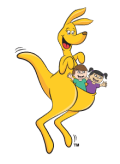Written by Dr Jane Williams, Dr Tessa Grigg and Bindy Cummings
There are currently products on the market that wedge a baby into a seated position from as early as three months of age. Any baby-sitting device, like the Bumbo, that locks a very young, non-mobile baby into a sitting position should be avoided and this is why.
While modern conveniences provide parents with lots of ‘containers’ into which babies can be placed, these very containers, which are seemingly designed to simplify our lives and protect our children can actually be preventing our babies from getting the very important sensory-motor experiences that promote healthy development.
The currently marketed seat for young babies is a seemingly convenient option for parents, but is it really beneficial to your baby?
The simple answer is no.
For healthy, normally developing babies, any ‘baby seat’ or sitting device like the Bumbo, where the baby is forced to sit into an upright posture with little upper body support should be avoided.
Believing they can assist development, parents may place their babies in these ‘baby seats’, or prop their babies up into a sitting position, at a very early age – sometimes as young as three months. Yet, despite the best of intentions, this position actually slows a baby’s pathway to mobility and hampers development.
While the manufacturers claim that devices like theirs allow a baby to ‘sit safely’, they are in fact, developmentally, doing the opposite. ‘Baby seats’ like the Bumbo actually position babies in a very unnatural posture. They force a baby into a leg-hugging, pelvis-tilting, bottom-sitting position. So, instead of making muscles stronger in preparation for forward movement, propped sitting actually prevents the muscles needed for movement to be strengthened. Muscles and joints develop through active movement, not through being passively forced into a certain position. In this type of device babies are not able to move freely and actively, denying them the opportunities to develop the muscle strength necessary for other movements, including crawling and creeping.
Passive propped sitting also denies the baby weight bearing opportunities necessary to develop muscle tone and strength. Without this weight bearing – developed so beautifully in the tummy time position – the joints and muscles don’t get the stimulation they need to ‘talk to the brain’ and the child is denied opportunities to develop good ‘body awareness’, an essential foundational building block for later movement skills and learning. In these devices a baby’s sense of touch (tactility) and sense of movement (vestibular) is reduced, as they are trapped in a bottom-hugging, leg-locking position. Vision is also affected, as visual perception is developed as a result of active movement, not passively ‘looking’.
So, parents beware! Positioning babies in this unnatural position places a baby’s development at risk. Remember for all babies, the floor is their best friend.
Healthy development that leads to sitting. When should a baby sit up?
The normal sequence of baby development follows this order: Rolling, pivoting, pushing backwards and lurching forward, moving forward on tummy, tummy crawling, sitting then creeping (crawling on hands and knees). Sitting early can interfere with this natural progression of skills, each of which plays a very important role in later learning and development (McWhirter, et al., 2024). Sitting early may also lead to bottom shuffling instead of the important movements of crawling and creeping.
Have a listen to Dr Jane Williams talking on this subject, in our free Active Babies Smart Kids online series: See full free video here.
Read more here: Please don’t sit me until I do it by myself.
How to encourage babies to move instead of placing them into a sitting position
There is no need to be in a hurry for your baby to sit. Nature will determine the timing. For now, simply help your little one to develop a brain and body ready for movement and sitting by providing the right environment:
- Tummy Time: Lots of tummy timehelps develop head control, visual fixation and tracking skills. If your baby is sitting and not creeping/crawling, try to encourage more tummy time. This could be tricky if your baby is able to sit herself up without your help, as she will just keep doing this! Don’t stress, but when the opportunity arises, encourage tummy time by playing lots of tummy games. Free tummy time video here.
- Vestibular stimulation: Rocking, rolling, spinning, dancing and moving, aid in the maturation of the balance organs and help with the development of good posture. Free baby balance video here.
- Massage: Stimulates blood supply to the muscles of the body and helps the development of muscle tone, so important for smooth and coordinated movement.
- Avoid any ‘baby seats’ like the Bumbo, that are marketed to keep non-sitting babies in a sitting position.
- Give lots of love and hugs – the most nourishing environment for healthy brain development.
- For hundreds of fun and loving ideas and activities to help your baby’s development, watch our entirely free ABSK online videos for parents and babies. This 12-part series is highly recommended by doctors, paediatricians, early childhood experts and the Maternal Child and Family Health Nurses Association.
Dr Jane Williams (PhD, BMgt, RN(Paeds)) is one of Australia’s leading experts on baby and child development.
Dr Tessa Grigg (PhD, B.Ed (Tchng Primary and ECE) is the Research and Education Manager for GymbaROO-KindyROO.
Bindy Cummings (B.Ed hons) is a teacher, a GymbaROO early childhood neuro-developmental consultant and the co-creator of GymbaROO’s Active Babies Smart Kids series. She has been writing articles for GymbaROO’s First Steps magazine, digital platforms and media for over ten years
References
McWhirter, K., Steel, A., & Adams, J. (2024). The association between learning disorders, motor function, and primitive reflexes in pre-school children: A systematic review. Journal of Child Health Care, 28(2), 402– 428. https://doi.org/10.1177/13674935221114187

